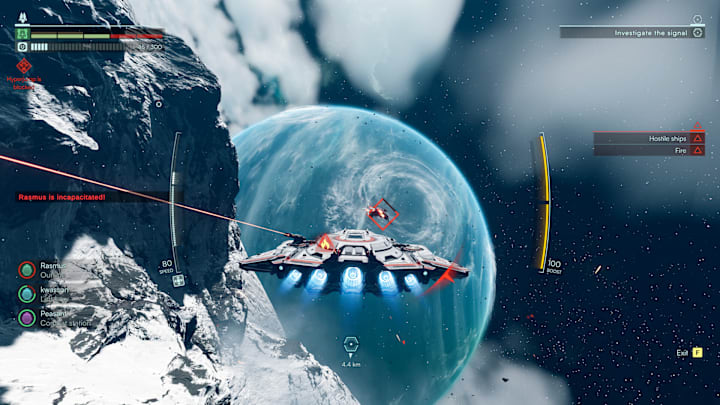Jump Space looks set to be the king of spacebound co-op games
By Kirk McKeand

Between Void Crew, Wildgate, and now Jump Space (previously called Jump Ship), 2025 is the year of teaming up with your pals to pilot a big spaceship. After playing all three, though, Jump Space stands out, even in the vastness of the cosmos.
The first thing that grabs you is how punchy it is. The on-foot shooting wouldn’t feel out of place in a near-future military shooter — it’s snappy and responsive, and the robotic enemies fizzle and crack as you pump them full of lead. At one point, I find a shoulder-mounted rail cannon that I use to take out an entire enemy spaceship while standing on the hull of our own craft, and it feels as satisfying as swatting a helicopter out of the sky with an RPG in Battlefield.
Spacewalking makes you feel like Iron Man. You can plant your mag boots and walk on any surface, but you can also detach and zoom through the void with your rocket pack at any time.
When piloting the ships, there’s an immediacy to the controls – which favour a more arcade style over sim controls – that makes you feel like an ace pilot from the off. You even get access to some point defense cannons you can fire off as you pilot, allowing you to feel like an active part of each battle even if you’re focusing on maneuvering the craft. The superstructures and asteroid fields dotted around space give you plenty of tactical options for positioning, escaping, and flanking.
The first ship also features two mounted cannons that can be manned by you or your crew (up to four people can play together) and these do devastating damage, but are limited by their viewing angles. The pilot has to work in tandem with the gunners to line up their shots.
Generally, while this is going on, another player runs around the ship putting out fires and dealing with broken down components. This is where Jump Space needs some work.
Your shields might as well be made of paper in Jump Space for all the good they do. Even if you still have shields, the first volley from any enemy will start a series of fires across your ship. There’s no avoiding it with skilled play, and it feels like the devs just made it work this way to ensure everyone has something to do. Instead of giving us two battle stations so skilled players can destroy enemies before taking damage, it’s always some poor sod’s task to run around fixing components. This should be a result of losing fights, not the default state of any combat situation. It’s almost entirely pointless to even spend resources on repairing shields.
There’s a circuit board of swappable parts onboard the ship where you can swap and change ship systems, or divert power where it’s needed most, but progress is slow going so we never felt like we needed to make sacrifices because there was always enough room for the few components we found.
Where Wildgate focuses on PvP, Jump Space is closer to Void Crew: it focuses on PvE and has a roguelite structure, where you plot a route to the end and deal with various hazards and opportunities in each sector. But what makes it stand apart is how every upgrade you earn stays with you, so your ship and character evolve over repeated sessions as you grab more valuable ship parts, weapons, and gear. The developers call your ship “a collective Diablo character” because of how your upgrades stay with each player on the crew and how it grows in power from run to run — so long as your ship survives the run.
Jump Space also features an AI director that tracks your ability and responds in real-time. If you take out a fleet of enemy ships too quickly, the next fleet might not be so passive. If you’ve had a lot of breathing room, it might throw an asteroid storm or some other anomaly at you. All of it works together to generate these personal stories where the systems interact to make cool things happen.
One area where Void Crew stands ahead of Jump Space, however, is in the relics you find. These work like upgrades in any other roguelike, offering buffs such as higher damage when shields are down, or shooting teammates heals them. Void Crew’s take on these was way more interesting, with the most powerful artifacts requiring careful play to avoid creating deadly consequences, such as freezing or overheating the ship. You can plop Jump Space’s relics into their slots and pretty much forget about them because they’re all fairly basic.
Of course, Jump Space is still in early access. It’s very barebones right now. The mission types constantly repeat, as do the 3D environments you find yourself in both on-foot and in space. There’s an entire currency that’s currently completely useless because the developers haven’t finished creating the economy for it yet. You can’t prepare your ship with items because of this. It’s a great time, but I kinda want to wait until 1.0 before I play more.
I’ve been enjoying this new wave of co-op space games a lot, but Jump Space seems to have more juice than all the ones I’ve already played. From the visuals to the mechanics, every part of the game feels polished and sharp, and you can tell it’s a real passion project from the devs. As one of the most-wishlisted games on Steam right now, it’s got a good shot at getting the audience it deserves when it launches tomorrow into Early Access on Steam and Xbox.